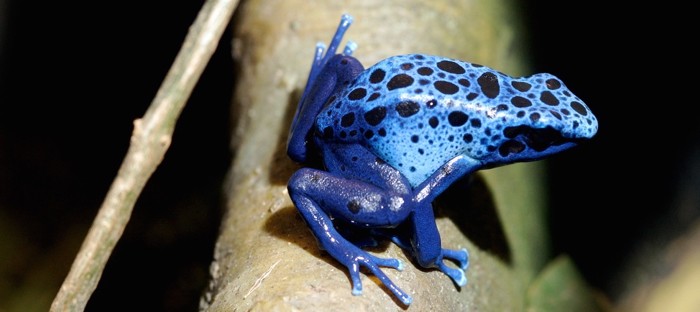Dart Frogs (Dendrobatidae spp.)
Natural history
Native to the tropical rain forests of Central and South America, tiny poison dart frogs secrete lipophilic alkaloid toxins through their skin. These toxins serve as a chemical defense against predation. Some native tribes are renowned for dipping arrow tips in the toxins from these frogs.
These beautiful, active frogs are outgoing and diurnal, making excellent “look but don’t touch” pets. Many but not all specimens in the pet trade today are captive bred. Frogs bred for several generations in captivity fail to synthesize skin alkaloid toxins because of differences in diet. However all specimens should be considered to be wearing noxious alkaloids on their skin until demonstrated otherwise.
Taxonomy
Class: Amphibia
Order: Anura
Family: Dendrobatidae
Dendrobates auratus: green and black poison frog
D. azureus: blue poison frog
D. leucomelas: yellow and black poison frog
Color and Size
These vividly colored frogs are tiny, typically reaching 1.5 in (3.8 cm) in length. Adult poison frogs typically weigh between 2-6 grams.
Diet
These small frogs have big appetites! Feed poison frogs small insects like fruit flies, termites, aphids, and pinhead crickets. Dust foods for juveniles with a vitamin/mineral supplement twice weekly. Dust food items for adults once weekly.
Husbandry
| Temperature | Provide a temperature gradient of 72-80°F (22-27°C) during the day. At night the temperature may fall to 65-70°F (18-21°C). Do not use a radiant heat source as these tend to dry amphibian environments. |
| Humidity/ water | Strive for a relative humidity of 80-100%. Provide a shallow water dish and lightly mist the enclosure regularly. Between misting the substrate should remain damp, but not water logged. Potential water sources include:
|
| Cage size and design | House one to four frogs in a heavily planted 20-gallon (75-L) terrarium. |
| Cage furniture/supplies | Provide plants and other visual barriers, as well as one or two tree limbs arranged diagonally. Provide low-intensity full-spectrum lighting for optimal absorption of dietary calcium. Dart frogs particularly enjoy commercially available huts made from coconut and bromeliads for climbing. |
| Social structure | Communal |
Lifespan
7-15 years (Green and black poison frog, yellow and black poison frog)
2-8 years (Blue poison frog)
Anatomy/ physiology
| Gastrointestinal: | A short, simple gastrointestinal tract empties into a cloaca |
| Dermatologic: | Dart frogs have the fragile, sensitive skin characteristic of all amphibians, plus are known for the skin secretions of toxic alkaloids. To protect the patient and clinician, moistened gloves should be worn for examination and treatment. |
| Cardiac: | A three-chambered heart is encased within the pectoral girdle. |
| Lymphatics: | All amphibians possess lymph hearts, which beat in synchrony independently of the heart. |
| Urogenital: | A renal portal system is present |
| Sexual dimorphism: | Males will call during the mating season. They will also develop nuptial pads on each thumb and tend to have darker throats. Females are usually larger than males with a more rounded body shape. | Miscellaneous: | Frogs possess coelomic and inguinal fat bodies. |
Restraint
Amphibian skin is very sensitive so handle the poison frog as little as possible. Perform a visual exam by placing the frog in a clear plastic box or tub.
To manually restrain the frog, moisten your hands with water or wear moistened latex gloves.
Important medical conditions
- Chytridiomycosis
- Spindly leg syndrome
**Login to view references**
References
References
Bartlett RD, Bartlett PB, Griswold B. Reptiles, Amphibians, and Invertebrates: An Identification and Care Guide, 2nd ed. Hauppage, NY: Barron’s Educational Series; 2010.
Lotters S, Jungfer KH, Henkel FW, Schmidt W. Poison Frogs: Biology, Species & Captive Husbandry. Serpent’s Tale. 2007.
Juchems J. Poison Dart Frogs: A Guide to Care and Breeding. Herpetol. Publ. 2011.
Wright KM, Whitaker BR. Amphibian Medicine and Captive Husbandry. Malabar (Kerala): Krieger; 2001.
Pollock C. Basic information sheet: Poison dart frogs. July 8, 2012. LafeberVet Web site. Available at https://lafeber.com/vet/basic-information-poison-dart-frogs/
